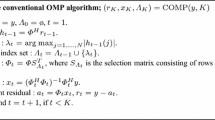Abstract
In this paper, we propose two novel recovery schemes for complex domain compressive sensing. Firstly, we present a new strategy to separate the real and imaginary parts of a complex signal for \(\ell _{1}\) minimization. While the method is simple, simulation results show that it is quite efficient because it reduces the sampling rate. Secondly, the least squares (LS) sub-problem is a key part of the orthogonal matching pursuit (OMP) algorithm and accounts for a large part of the computational load. We employ the Landweber algorithm to efficiently solve the LS problem. Furthermore, we propose four new parameter options to accelerate the convergence. Our numerical experiments show that our method is competitive with the pseudo-inverse.





Similar content being viewed by others
References
R. Baraniuk, P. Steeghs, Compressive radar imaging. in IEEE Radar Conference (Waltham, Massachusetts, April 2007), pp. 128–133
S. Boyd, L. Vandenberghe, Convex Optimization (Cambrige University, Cambrige, 2004)
C. Byrne, Iterative Algorithms in Inverse Problems (University of Massachusetts Lowell Libraries, Lowell, 2006)
E.J. Candès, \(\ell _{1}\)-MAGIC: recovery of sparse signals via convex programming. (2004) http://www-stat.stanford.edu/~candes/l1magic/
E.J. Candès, J. Romberg, T. Tao, Robust uncertainty principles: exact signal reconstruction from highly incomplete frequency information. IEEE Trans. Inf. Theory. 52(2), 489–509 (2006)
E.J. Candès, T. Tao, Decoding by linear programming. IEEE Trans. Inf. Theory. 51(12), 4203–4215 (2005)
E.J. Candès, T. Tao, Near optimal signal recovery from random projections: universal encoding strategies? IEEE Trans. Inf. Theory. 51(12), 5406–5425 (2006)
W.L. Chan, M.L. Moravec, R.G. Baraniuk, D.M. Mittleman, Terahertz imaging with compressed sensing and phase retrieval. Opt. Lett. 33(9), 974–976 (2008)
G. Coluccia, E. Magli, A novel progressive image scanning and reconstruction scheme based on compressed sensing and linear prediction. in IEEE International Conference on Multimedia and Expo (ICME) (Melbourne, Australia, July 2012), pp. 866–871
I. Cumming, F. Wong, Digital Processing of Synthetic Aperture Radar Data (Artech House, Norwood, 2005)
L. Dai, Z. Wang, Z. Yang, Compressive sensing based time domain synchronous OFDM transmission for vehicular communications. IEEE J. Sel. Area Commun. 31(9), 460–469 (2013)
S. Das, T. Sidhu, Application of compressive sampling in synchrophasor data communication in WAMS. IEEE Trans Ind. Informat. 10(1), 450–460 (2014)
J. Ding, L. Chen, Y. Gu, Perturbation analysis of orthogonal matching pursuit. IEEE Trans. Signal Process. 61(2), 398–410 (2013)
D. Donoho, Compressed sensing. IEEE Trans. Inf. Theory. 52(4), 1289–1306 (2006)
L. Fang, S. Li, R.P. Mcnabb, Q. Nie, A.N. Kuo, C.A. Toth, J.A. Izatt, S. Farsiu, Fast acquisition and reconstruction of optical coherence tomography images via sparse representation. IEEE Trans. Med. Imag. 32(11), 2034–2049 (2013)
S. Foucart, H. Rauhut, in A Mathematical Introduction to Compressive Sensing (Birkhäuser, Boston, 2013)
T. Glodstein, S. Osher, The split Bregman method for \(L_{1}\)-regularized problem. SIAM J. Imaging Sci. 2(2), 323–343 (2009)
D. Gross, Y.K. Liu, S.T. Flammia, S. Becker, J. Eisert, Quantum state tomography via compressed sensing. Phys. Rev. Lett. 105(15) (2010) arXiv:0909.3304
M. Hayes, P. Gough, Synthetic aperture sonar: a review of current status. IEEE J. Ocean. Eng. 34(3), 207–224 (2009)
H. Liu, B. Song, H. Qin, Z. Qiu, Dictionary learning based reconstruction for distributed compressed video sensing. J. Vis. Commun. Image. R. 24(8), 1232–1242 (2013)
C. Luo, M.A. Borkar, A.J. Redfern, J.H. Mcclellan, Compressive sensing for sparse touch detection on capacitive touch screens. IEEE J. Emerg. Sel. Top. Circ. Syst. 2(3), 639–648 (2012)
M. Lustic, D.L. Donoho, Sparse MRI: the application of compressed sensing for rapid MR imaging. Magn. Reson. Med. 58(6), 1182–1195 (2007)
E. Magesan, A. Cooper, P. Cappellaro, Compressing measurements in quantum dynamic parameter estimation. (2013) arXiv:1308.0313v1
E. Matusiak, Y.C. Eldar, Sub-Nyquist sampling of short pulses. IEEE Trans. Signal Process. 60(3), 3944–3947 (2012)
D. Mittleman, Sensing with Terahertz Radiation (Springer, Berlin, 2003)
N. Parikh, S. Boyd, Proximal algorithms. Found. Trends Optim. 1(3), 123–231 (2013)
L. Poli, G. Oliveri, P. Rocca, A. Massa, Bayesian compressive sensing approaches for the reconstruction of two-dimensional sparse scatterers under TE illumination. IEEE Trans. Geosci. Remote Sens. 51(5), 2920–2936 (2013)
L. Poli, G. Oliveri, F. Viani, A. Massa, MT-BCS-based microwave imaging approach through minimum-norm current expansion. IEEE Trans. Antennas Propag. 61(9), 4722–4732 (2013)
G.R. Qu, C. Wang, M. Jiang, Necessary and sufficient convergence conditions for algebraic image reconstruction algorithms. IEEE Trans. Image Process. 18(2), 435–440 (2009)
M. Rossi, A.M. Haimovich, Y.C. Eldar, Spatial compressive sensing for MIMO radar. IEEE Trans. Signal Process. 62(2), 419–430 (2013)
M. Rudelson, R. Vershynin, Sparse reconstruction by convex relaxation: Fourier and Gaussian measurements. in Proceedings of the 40th Annual Conference Information Sciences and Systems (CISS) (Princeton, March 2006), pp. 207–212
J. Tropp, A. Gilbert, Signal recovery from random measurements via orthogonal matching pursuit. IEEE Trans. Inf. Theory. 53(12), 4655–4666 (2007)
A. Webb, Magnetic resonance imaging. in Introduction to Biomedical Imaging (Wiley-Interscience, Hoboken, 2003), pp. 157–219
S.J. Wright, Primal-Dual Interior-Point Methods (SIAM, Philadelphia, 1997)
J. Yang, J. Thompson, X. Huang, T. Jin, Z. Zhou, Random-frequency SAR imaging based on compressed sensing. IEEE Trans. Geosci. Remote Sens. 51(2), 983–994 (2013)
Author information
Authors and Affiliations
Corresponding author
Additional information
Partially supported by the National Natural Science Foundation of China (61071144; 61271012).
Rights and permissions
About this article
Cite this article
Kang, R., Qu, G. & Wang, B. Two Effective Strategies for Complex Domain Compressive Sensing. Circuits Syst Signal Process 35, 3380–3392 (2016). https://doi.org/10.1007/s00034-015-0202-6
Received:
Revised:
Accepted:
Published:
Issue Date:
DOI: https://doi.org/10.1007/s00034-015-0202-6




